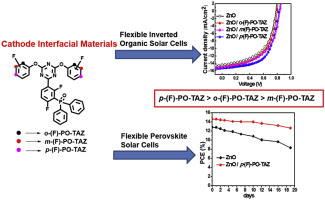Organic Electronics ( IF 2.7 ) Pub Date : 2017-12-16 , DOI: 10.1016/j.orgel.2017.12.017 Nallan Chakravarthi , Ho-Yeol Park , Kakaraparthi Kranthiraja , Hyein Kim , Jongmoon Shin , Myungkwan Song , Sung-Ho Jin

|
The grand challenge involved in inverted organic solar cell (IOSC) and perovskite solar cell (PSC) technology is to control the interfacial losses at the interface of the photoactive layer with the electron extracting electrode. Herein, three organic small molecules, namely o-(F)-PO-TAZ, m-(F)-PO-TAZ and p-(F)-PO-TAZ, consisting of phosphine oxide (PO) functionalized 1,3,5-triazine (TAZ) with a fluorine atom (
F) at the ortho (o)/meta (m)/para (p) positions of the phenoxy group attached to the TAZ unit are developed via a rational design approach and used as cathode interfacial layers (CILs) in flexible IOSCs and PSCs. We realized that the
F position particularly affects the glass transition temperature (Tg) of the PO-TAZ derivatives, which in turn exerts a positive effect by maintaining robust and smooth morphological features. This gives the IOSC and PSC devices an
F position-dependent performance. Particularly, ZnO/p-(F)-PO-TAZ-based flexible IOSC and PSC devices display not only high power conversion efficiencies (PCEs) of 7.68% and 14.64% but also long-term stability that are superior to those of the control and o-(F)- and m-(F)-PO-TAZ-based solar cell devices. The current work offers new findings on constructing photoactive (organic or perovskite) layer/CIL interfaces and assists in the rational design of CILs to facilitate efficient photovoltaic devices.
中文翻译:

用于柔性有机和钙钛矿太阳能电池的氧化膦官能化三嗪基阴极界面材料的取代基位置工程
倒置有机太阳能电池(IOSC)和钙钛矿太阳能电池(PSC)技术涉及的重大挑战是控制光敏层与电子引出电极的界面处的界面损耗。本文中,由功能化1,3,3的氧化膦(P O)组成的三个有机小分子,即o-(F)-PO-TAZ,m-(F)-PO-TAZ和p-(F)-PO-TAZ通过合理的设计方法开发了在与TAZ连接的苯氧基的邻位(o)/间位(m)/对位(p)位置具有氟原子(
F)的1,5-三嗪(TAZ)柔性IOSC和PSC中的阴极界面层(CIL)。我们意识到
F位置特别影响PO-TAZ衍生物的玻璃化转变温度(T g),进而通过保持稳固而平滑的形态特征而发挥积极作用。这使IOSC和PSC设备具有与
F位置相关的性能。特别是,基于ZnO / p-(F)-PO-TAZ的柔性IOSC和PSC器件不仅显示出7.68%和14.64%的高功率转换效率(PCE),而且还显示出优于对照组的长期稳定性。和o-(F)-和m-(F)-PO-TAZ基太阳能电池设备。当前的工作提供了有关构造光敏(有机或钙钛矿)层/ CIL界面的新发现,并有助于合理设计CIL以促进高效的光伏设备。











































 京公网安备 11010802027423号
京公网安备 11010802027423号